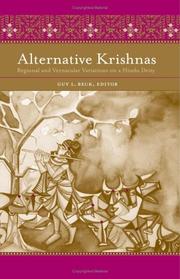| Listing 1 - 2 of 2 |
Sort by
|

ISBN: 079148341X 1423744063 9781423744061 0791464156 9780791464151 9780791483411 Year: 2005 Publisher: Albany : State University of New York Press,
Abstract | Keywords | Export | Availability | Bookmark
 Loading...
Loading...Choose an application
- Reference Manager
- EndNote
- RefWorks (Direct export to RefWorks)
Krishna—widely venerated and adored in the Hindu tradition—is a deity of many aspects. An ancient manifestation of the Supreme God Vishnu, or the Godhead itself, Krishna is the bringer of Yoga philosophy and the creator of the universe, the destroyer of evil tyrants, and the hero of the epic Mahabharata. He is also described in classical Sanskrit texts as having human characteristics and enjoying very human pursuits: Krishna is the butter thief, cowherd, philanderer, and flute player. Yet even these playful depictions are based upon descriptions found in the Sanskrit canon, and mostly reflect familiar, classical Pan-Indian images.In this book, contributors examine the alternative, or unconventional, Krishnas, offering examples from more localized Krishna traditions found in different regions among various ethnic groups, vernacular language traditions, and remote branches of Indian religions. These wide-ranging, alternative visions of Krishna include the Tantric Krishna of Bengal, Krishna in urban women's rituals, Krishna as monogamous husband and younger brother in Braj, Krishna in Jainism, Krishna in Marathi tradition, Krishna in South India, and the Krishna of nineteenth-century reformed Hinduism.
Hinduism --- Customs and practices. --- Krishna --- Christna --- Gopal --- Kr̥ṣṇa --- Govinda --- Mohan --- Gopala --- Bal Gopal --- Cult. --- Krishna (Hindu deity) --- Radha --- Vaishnava Sahajiya Tantric traditions --- Vaishnavism --- the Thakur Pancayat --- Krishna statues --- Hindu women --- ritual tradition --- Radhavallabha Sampradaya --- Dauji --- Balarama --- Pandharpur --- early medieval South India --- Vasudeva Krishna --- Jaina cosmohistory --- Radha's Arbor --- Bhakti --- Hariaudhi's Priyapravas --- Holi

ISBN: 1597347752 1282357964 9786612357961 0520938348 1417584955 9780520938342 9781597347754 9781417584956 0520243137 9780520243132 0520243145 9780520243149 9781282357969 6612357967 Year: 2005 Publisher: Berkeley : University of California Press,
Abstract | Keywords | Export | Availability | Bookmark
 Loading...
Loading...Choose an application
- Reference Manager
- EndNote
- RefWorks (Direct export to RefWorks)
At South Indian village funerals, women cry and lament, men drink and laugh, and untouchables sing and joke to the beat of their drums. No One Cries for the Dead offers an original interpretation of these behaviors, which seem almost unrelated to the dead and to the funeral event. Isabelle Clark-Decès demonstrates that rather than mourn the dead, these Tamil funeral songs first and foremost give meaning to the caste, gender, and personal experiences of the performers.
Funeral rites and ceremonies --- Tamil (Indic people) --- Dirges --- Folk songs, Tamil --- Tamil ballads and songs --- Tamil folk songs --- Funeral hymns --- Laments --- Tamal (Indic people) --- Tamalsan (Indic people) --- Tambul (Indic people) --- Tamili (Indic people) --- Tamils --- Ethnology --- Funerals --- Mortuary ceremonies --- Obsequies --- Manners and customs --- Rites and ceremonies --- Burial --- Cremation --- Cryomation --- Dead --- Mourning customs --- Funeral customs and rites. --- History and criticism. --- Social life and customs. --- anthropology. --- behavioral analysis. --- caste system. --- ceremonial. --- cultural analysis. --- death songs. --- death. --- discussion books. --- funeral event. --- funeral singers. --- funeral songs. --- funerals. --- gender issues. --- graveyard petitions. --- grief and mourning. --- historical. --- indian culture. --- life and death. --- nonfiction. --- performers. --- personal experiences. --- rowdy songs. --- social behaviors. --- social customs. --- sociologists. --- sociology. --- south india. --- tamil dirges. --- tamil. --- untouchables. --- village setting.
| Listing 1 - 2 of 2 |
Sort by
|

 Search
Search Feedback
Feedback About UniCat
About UniCat  Help
Help News
News